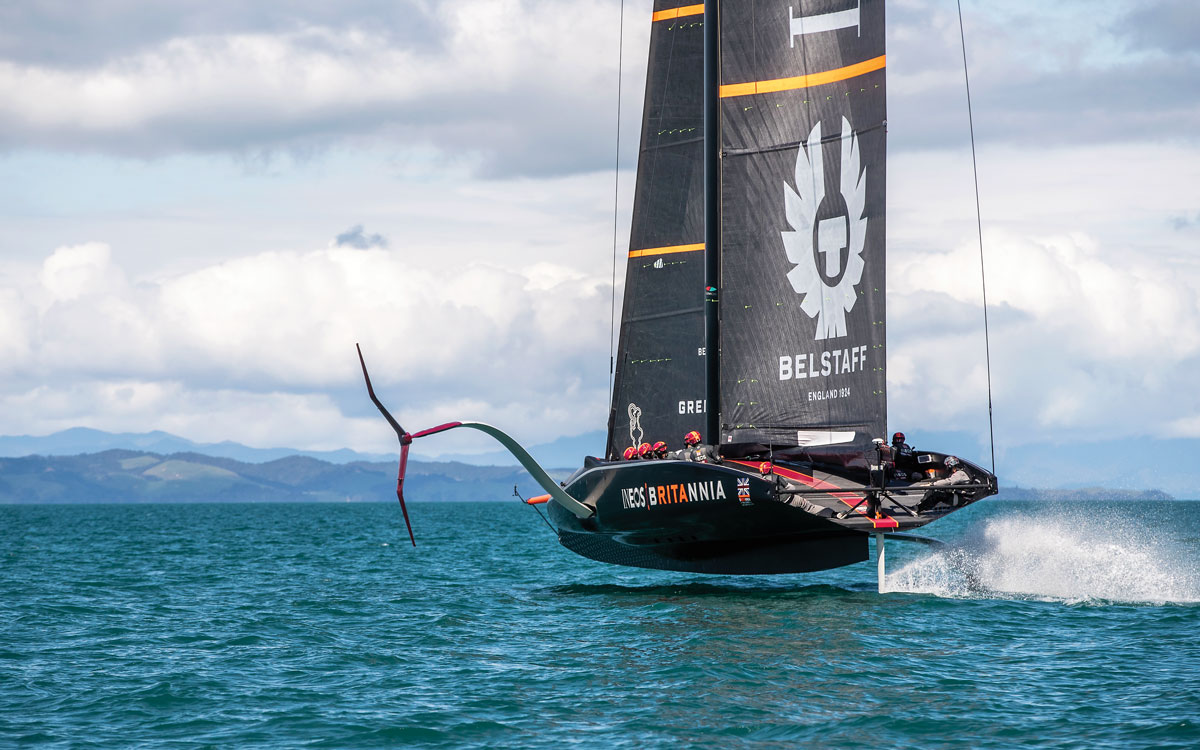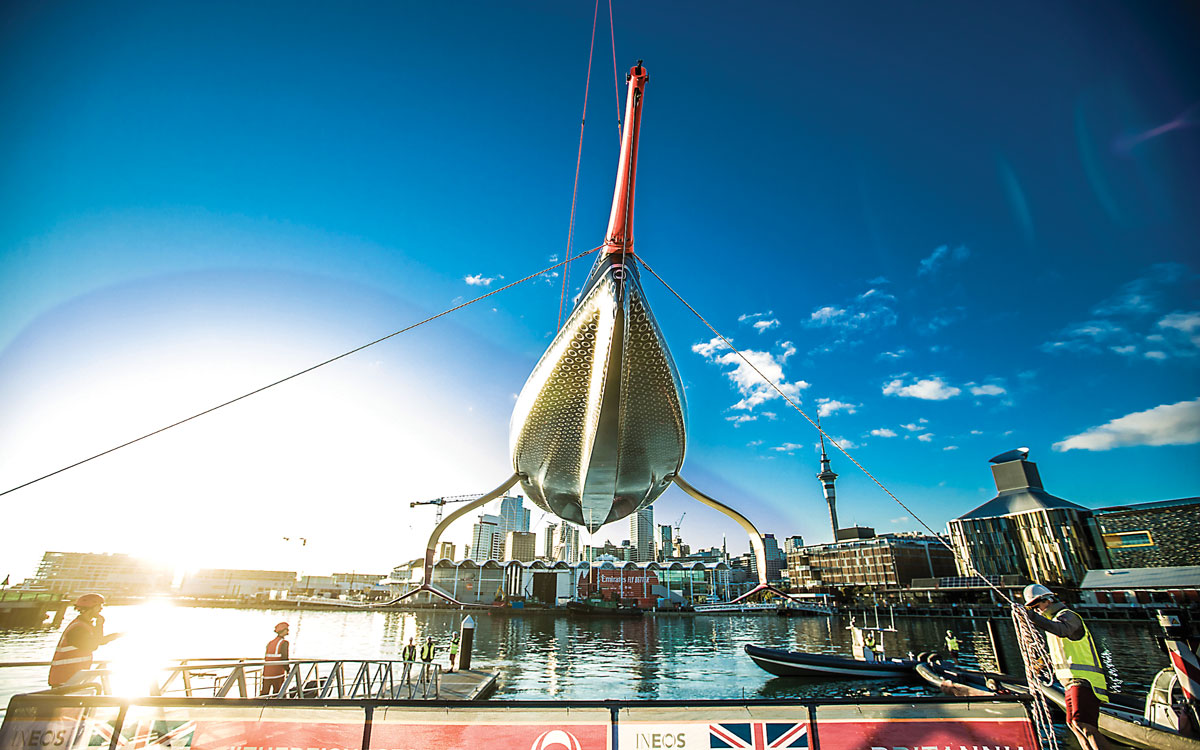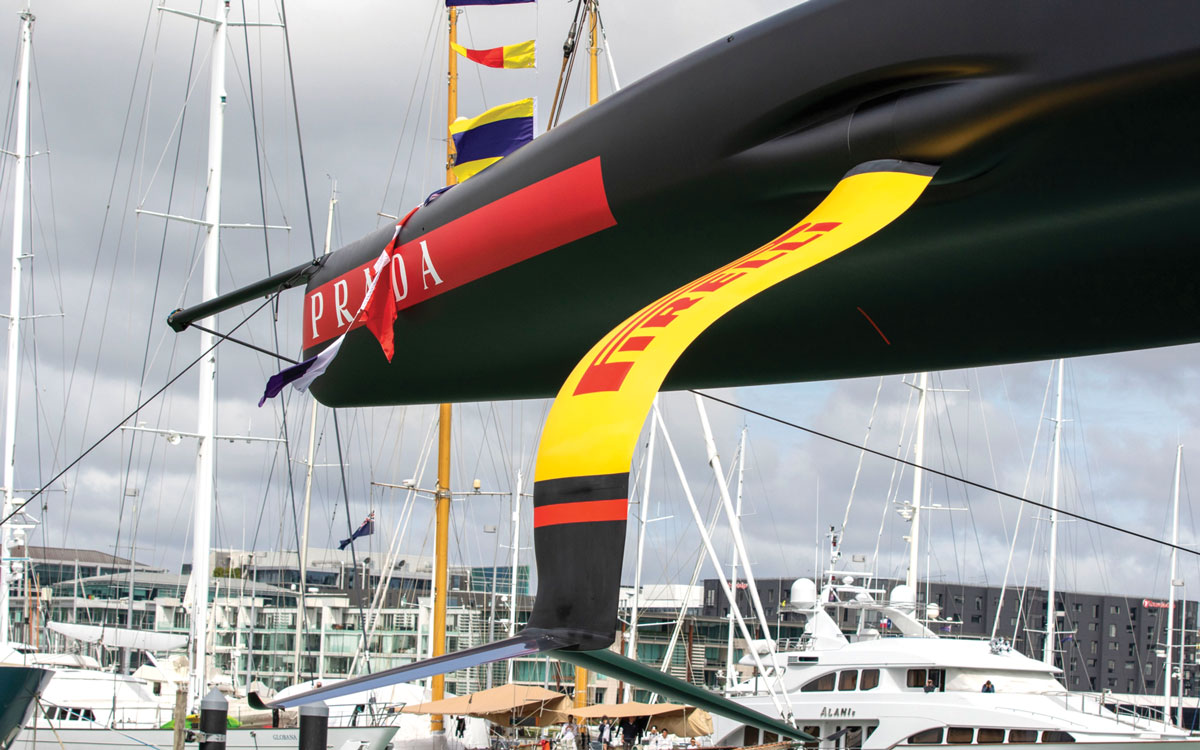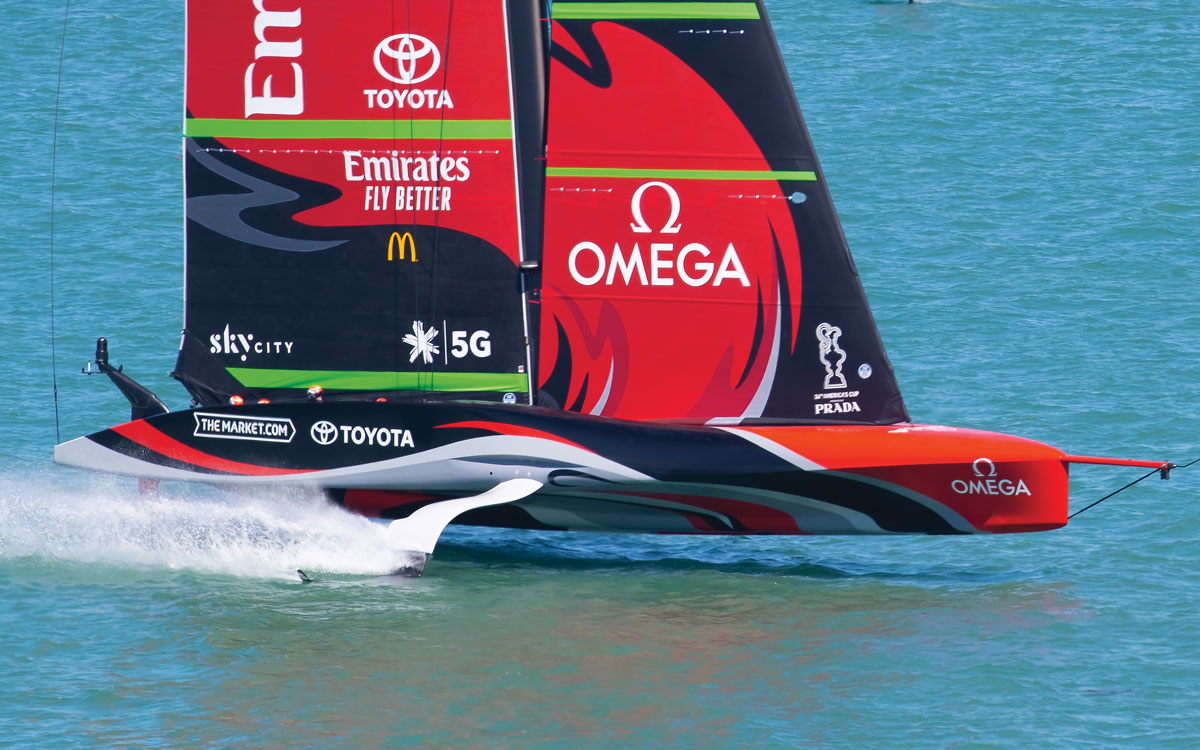The three challengers will start their assault on the America's Cup this week as the Prada Cup gets underway. Matt Sheahan assesses each of the teams
As each of the new AC75s were wheeled out into the open for the first time, amid the celebration and champagne spraying, each team will have been keenly aware that this was it.
Barring disasters, these were the boats that would face each other on the start line. After more than two years of planning, scheming, data-crunching, building, testing and training, this was their shot at the America’s Cup.
The pressure has been made even greater by a distinct lack of any opportunity to compare themselves against the other teams, after the two 2020 America’s Cup World Series events in Sardinia and Portsmouth fell victim to the pandemic.
Article continues below…
INEOS Team UK grinder David Carr explains what it’s really like to sail an AC75
“When you push off the dock, your life is in the hands of computers – and the guy piloting the…
Road to the America’s Cup podcast: What can sailing simulators teach us?
The reason is simple: every other means of performance evaluation has been neutered – or, at the very least, significantly…
Had they gone ahead, these regattas would have provided valuable intelligence about the relative performance differences across the fleet, and some clues about which design approach was pursuing the right path. Much of that knowledge would have been gained while there was still time to do something about it. Now there is none.
The result is that, despite all the ‘competitive reconnaissance’ – or what you and I would call spying – that every team has been engaged in since the 36th America’s Cup cycle started, rarely has so little been known by the competitors about their opponents.
True there has been opportunity for the four teams to pit themselves against one another in the America’s Cup World Series and Prada Christmas Cup – the latter ultimately cut short due to a lack of wind – but this represented very little competitive sailing for all teams.
Not that the lack of racing has stopped others from speculating on the relative speeds of each team. Before the launches, there was a school of thought that, despite some wildly different design approaches for the first boats, the second AC75s might show the four designers’ thinking had shifted towards a similar corner of the rule. But when the new boats were unveiled it was clear that such a consensus did not exist.
Ineos Team UK
The boat – Britannia II
There’s no disputing the British boat is the most extreme of the challengers. The most noticeable feature is her chunky, aggressive skeg that starts like a battering ram at the plumb bow and runs down the centreline, stopping just in front of the rudder.
The broad purpose of a long skeg, to maintain an aerodynamic seal between the hull and the water’s surface as the boat begins to fly, is becoming increasingly clear, but little is yet known about why chief designer Nick Holroyd and the British team have gone for such a chunky configuration.
“It has benefits through the take off and aerodynamically when the boat’s flying as well,” Holroyd said of the ‘bustle’, as he referred to it.
Interestingly this deep, box section affair doesn’t appear to be aero- or hydro-dynamically sympathetic until you look from under the boat. From this angle the bulge in the box section as it travels aft suggests that the skeg is generating hydrodynamic lift somewhere around midway down its length.
This would imply that the longitudinal position of maximum lift would be somewhere near the foils. Perhaps, when the boat is heeled to weather and getting ready to take off, the water flow on the windward side reduces leeway by sucking the boat up to windward which helps to get the leeward foil working?
There’s also a question whether the box type section of the skeg provides a lighter structural beam to make the hull stiffer fore and aft. If this is the case it could be that space has been freed up inside for systems and/or that it means the weight budget for structure can be used in other areas.
Another interesting feature is the distortion in the hull shape aft which appears to be a way of reducing the waterline beam and therefore wetted surface area quickly as the boat lifts, which in turn will provide a step change in acceleration – a performance aspect that will doubtless prove critical on a race course that has plenty of corners and boundaries to accelerate away from.
“Slow speed manoeuvring is quite difficult and the initial stage of acceleration is tricky,” said team pilot Leigh McMillan, the crew member responsible for flight. “[But] the acceleration through the mid-range is going to be a huge step forward.”
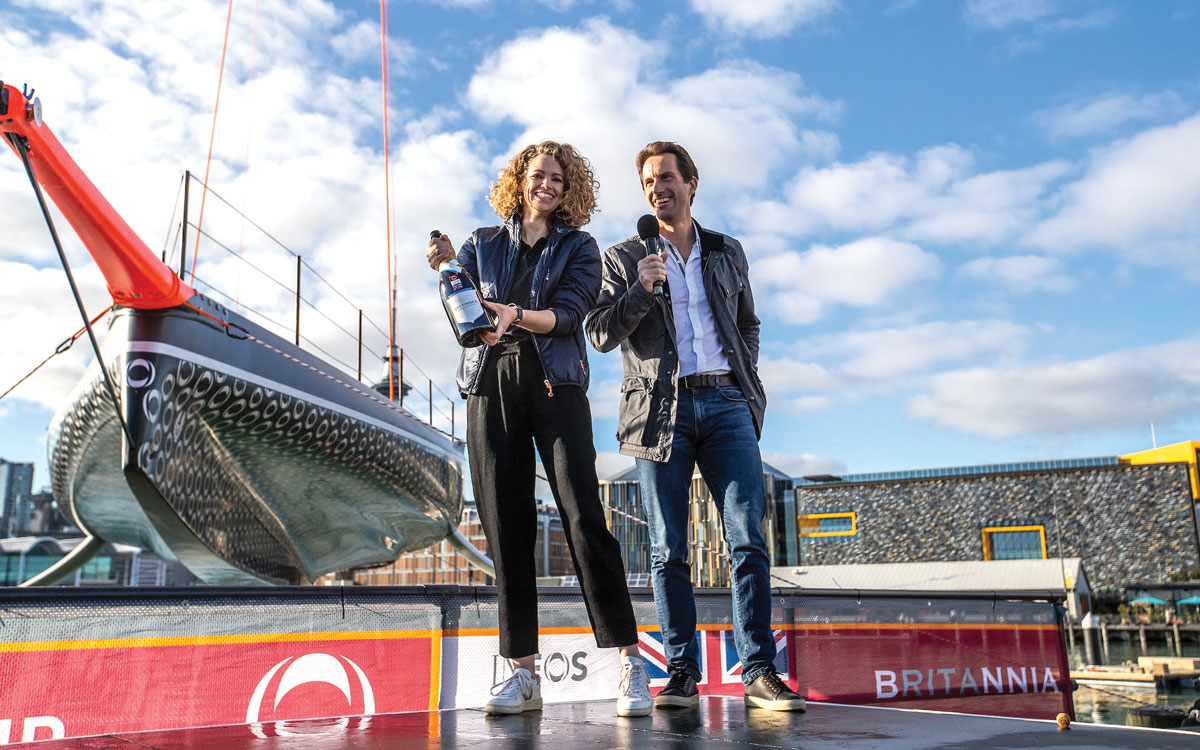
The British High Commissioner for New Zealand, Laura Clarke, helped Sir Ben Ainslie christen the boat in Auckland. Photo: Harry KH
How are they faring so far?
Whichever way you look at it, Britannia II is a radical shape but so far the team will be disappointed with their showing on the America’s Cup World Series, where they were clearly the slowest team by a distance.
The British boat does not seem to be particularly sluggish in a straight line so far as can be said based on what little was seen in the ACWS, but they do appear to struggle to get up on their foils as quickly as the other boats and seem to drop off them a little earlier.
Any number of factors could well be contributing to this from the ‘soft wingsail’ not providing sufficient camber and so power at the bottom of the wind range, or the foils not being quite as optimised or any number of other factors.
Ainslie was relatively forthright about the work they had ahead at the end of the event stating that: “We’ve got the spend the next two or three weeks making some big changes to the set up.
“Clearly, as we keep saying, there are issues with our performance in the down-speed sections and we’re obviously trying to evaluate that, work out what’s causing that, and rectify it.” We’ll soon see if they have managed to fix their issues but it was far from a dream start to competitive proceedings for the Brits.
The crew
Over 170 years of America’s Cup racing, Britain has what can only be described as the longest losing streak in history. The Brits were left bruised after defeat in Bermuda, and there have been a few changes since then.
On the AC75 Giles Scott is calling tactics for skipper Ben Ainslie, with Leigh MacMillan as flight controller. Add in Cup veterans David Carr and Nick Hutton, and some additional muscle from the likes of Olympic rower Matt Gotrel, and the team seems settled and tight-knit.
Luna Rossa Prada Pirelli
The boat – Luna Rossa
The Italians’ Luna Rossa looks the sleekest of them all. With smooth elegant lines and a complete absence of hard edges or distortions, this is a boat designed to fly rather than float.
When viewed in elevation, the hump in the sheerline from midships aft seems to highlight just how important aerodynamic lift is and how the deck can now be used to contribute to lifting the 7-tonne beast out of the water.
Similar to Patriot, Luna Rossa has a skeg that blends its way out of a bow (that in profile looks like it came from their 2002 IACC boat), before running down the centreline to stop in front of the rudder. Even so, this is the most modest of all the skegs.
“We’re pretty happy with what we have done and the evolution of our boat,” said chief designer Horacio Carabelli. “I think we have stepped up pretty well. It’s just small details that we really improved from our first generation boat.”
Although Carabelli and the team were keen to play down any developments that may have taken place between boat one and boat two, the 2020 chatter was about how sophisticated their first boat looked.
Perhaps the reality is that Luna Rossa was a lot further down the hull development line than the other two challengers for their first boat and have since been able to concentrate on other details that are less obvious. They were the only team to mask out shots of the twin cockpits.
Within those twin cockpits lurks a unique feature of the Luna Rossa boat with the Italian team electing to go for a twin or split helmsman option. Jimmy Spithill will steer the boat on starboard tack while Francesco Bruni steers the boat on port, with neither helmsman crossing the boat at any point during racing.
With all other boats we see helmsman running across the boat after manoeuvres while another member of the afterguard temporarily holds the wheel. It seems the ‘spare’ helmsman can then offer tactical input from the leeward side and possibly takes on foil control or mainsail traveller control.
How are they faring so far?
What it does mean, and this could clearly be seen in the America’s Cup World series, is that Luna Rossa is extremely manoeuvrable and they were the only team to look unharried by multiple manoeuvres, such as mark roundings immediately followed by a tack, or quick tacks in succession. It hardly need be spelled out what a boon this could be in a tight match racing situation.
The crew
The Luna Rossa Prada Pirelli team hasn’t been afraid of ruffling a few feathers in the run-up to this Cup, but helmsman Jimmy Spithill isn’t the type to be bothered by a bit of conflict.
With a Cup record equalled only by Russell Coutts, Spithill is a very hard man to bet against. Team skipper Max Sirena has also been on the winning side both alongside and against Spithill, with USA 17 in 2010 and ETNZ’s winning crew last time.
American Magic
The boat – Patriot
The American team were first to launch both iterations of the AC75. On the face of it, Patriot looks much like her sistership Defiant, but the differences start to become clear when you look at her bow.
Gone is the scow shape with its overblown Topper dinghy-style deck and flat bow sections and in comes more of a V-type bow, albeit still under a beamy foredeck.
Here, the flared forward sections create the start of the centreline skeg that runs aft for around 75% of her length. Skegs have become a feature of all four new boats as designers attempt to maintain the seal between the hull and the water’s surface for as long as possible in order to maintain aerodynamic efficiency.

American Magic’s slender hull and curved deck is influenced by the smooth aerofoil shape of an aircraft’s wing. Photo: Will Ricketson
“The flare in the bow is just maximising the driving force and minimising the heeling moments that you’re producing,” explained designer Marcelino Botin. “The bow shape and the whole boat is guided towards that objective.”
Apart from a high gloss finish that is very effective at concealing what she really looks like, Patriot is notable for her smooth, undistorted shape below the waterline and her aerodynamic shape above.
“You should look at the hull shapes as a continuation of the rig and the sail plan,” continued Botin. “What you’re trying to achieve with the hull is to maximise the driving force of the rig and the sails and minimise the heeling moment, it’s as simple as that.”
If you look at all of the designs with this in mind you can see areas where this is the case: one example is the wide flat central section of the deck between the crew (who are lined fore and aft up along each gunwale), which dips gently towards the cockpit sole as it sweeps aft keeping the airflow over the deck and around the bottom of the mainsail clean.
With apparent wind speeds that are regularly in the 40-60 knots range it’s not difficult to see how a curved deck like this can act as a lifting device; there are plenty of aircraft that fly at these speeds and less.
Another notable point is the depth of the rudder. The top of the blade has a long chord to provide control at slow sub foiling speeds while the lower tip of the blade is a painfully skinny affair to reduce drag and avoid cavitation.
How are they faring so far?
Patriot was the stand-out performer of the challengers in the America’s Cup World Series and were the only team to beat the America’s Cup Defender, Emirates Team New Zealand in a race.
The American team’s tactic of launching each iteration of AC75 first and getting as much time on the water in them as possible seems to have paid off, at least initially, whether the other two challengers are able to bridge that gap and whether others have a package that is ultimately quicker with more time to set up remains to be seen, but it would certainly not be a surprise should Patriot line up against the Kiwis come the America’s Cup final based on their ACWS pace.
The crew
It will have been a strange homecoming for Dean Barker when he arrived back in New Zealand to take the wheel of Patriot. Barker was the country’s hero when he won the Auld Mug for the black boat in 2000, but after losing twice to Alinghi and then to BMW Oracle in 2013 he was removed from the skipper position and has been helming for other nations since.
As well as skipper Terry Hutchinson, much of the team’s DNA comes from backers ‘Hap’ Fauth and Doug DeVos’s successful Bella Mente and Quantum Racing programmes.
The Defender
Emirates Team New Zealand
The boat – Te Rehutai
Emirates Team New Zealand, as holder and Defender of the America’s Cup will not compete in the Prada Cup, that competition is merely to decide who gets the right to sail against the Kiwis in the America’s Cup match itself. However, all the signs point to the New Zealanders being a more than worthy opponent for whoever comes out as the top challenger.
It’s difficult to overstate how eagerly anticipated the launch of the Kiwi’s second boat was. Besides being the current America’s Cup holder, Emirates Team New Zealand has set the foiling agenda since 2012.
Being the architects of the new rule delivered another opportunity to stretch further ahead. This is how the Cup works: win it and you get to make the rules. This is a design team that has been ahead of the curve for two consecutive Cup cycles already.
The most striking aspect of the new boat is how similar in concept it looks to that of INEOS Team UK. Despite their different starting points, the two teams appear to have arrived at a similar design place.
The aggressive, muscular approach is first evident with a long, deep and chunky skeg that runs the full length of the boat. Like on the other AC75s, this feature provides an aerodynamic seal up until the point at which the boat starts to take flight, plus it may also contribute to the hydrodynamic side force at displacement speeds.
When viewed from underneath it appears to be a more parallel sided section than that on the British boat. It is also possible that this chunky skeg provides an efficient, beefy structural spar for longitudinal stiffness.
Then there is the heavy flare in the forward sections of the hull, which roll out into flat, horizontal sections aft.
Such clean flat areas pushed out to maximum beam result in vertical topsides, suggesting the Kiwis believe there is a well defined step between displacement sailing (where maximum form stability will be required), and flight. The complex underwater shapes of the British approach suggest that there are more stages to this transition.
It is this transition, and how it impacts on the ability to accelerate quickly, that is one of the key cornerstones of performance, as confirmed by ETNZ’s head of design Dan Bernasconi.
“We’ve been searching for the perfect balance between hydrodynamic and aerodynamic performance,” he said. “An AC75 that was optimised purely to accelerate and take-off would look very different to one which was optimised for steady flight, and that’s reflected in the huge variation we see between our competitors’ yachts in the fleet.
“Te Rehutai is designed to excel in both domains – the water and the air – and we’re confident she’ll be competitive across the range of wind-speeds we may see in the America’s Cup.”
How are they faring so far?
It’s hard to see the Kiwis’ performance in the America’s Cup World Series as anything other than ominous – unless you happen to be one of the many die-hard New Zealand supporters who will, no doubt, be delighted.
The Cup holders did look beatable on the water, losing a race to Patriot, but even during that tight battle they looked to have a click more boatspeed at certain times with tactical or crew work errors the key factor in any less-than-stellar performances.
You would typically pick the Defender as the favourite to win any America’s Cup match – that is a large part of why the trophy is so unique and elusive – and this cup cycle looks to be no different. No matter what secret developments arrive for the challengers between now and the start of the America’s Cup itself in March, the Kiwis are the clear team to beat.
The crew
There are few sailing partnerships as successful, and apparently as near-telepathic, as Pete Burling and Blair Tuke. The multiple 49er world champions, gold and silver medallists and America’s Cup holders have an uncanny ability to get the best out of every boat they step on, so it’s no surprise that while Burling steers the AC75 Tuke will be flight controller.
The rest of the squad reads like a who’s who of yachting, from CEO Grant Dalton to a design team that includes Guillaume Verdier, not least sailors like Glenn Ashby and Ray Davies.
Additional reporting by Toby Heppell.







